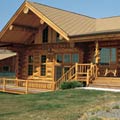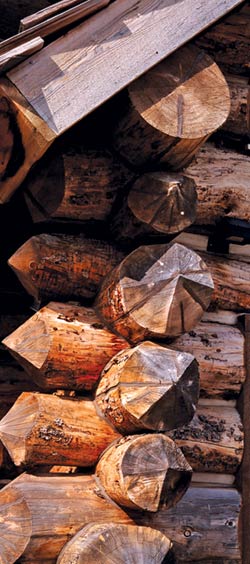 |
Building a Handcrafted Home 6 tips for planning and building handcrafted log homes |
Handcrafted log homes represent a time-honored tradition and offer abundant charm. Here are 6 ways to ensure a smooth building process.
1. My husband and I love milled and handcrafted homes, but for our Montana cabin, we’re leaning toward a handcrafted beauty. What are the biggest factors we need to consider when choosing a handcrafter?
 First, consider style. Handcrafted log homes aren’t all alike. Compare the size and shape of logs, corner joinery and how logs are stacked. Some handcrafters specialize in using logs with unique features or shapes. Some specialize in hand-hewn square logs, while others work with round logs. Some use joinery systems that leave spaces between log courses, which are sealed with chinking to create a quintessential rustic look. Other handcrafters scribe logs so each piece of timber closely follows the contour of the wood beneath it. Also, most handcrafters work with one or a few species of wood—whatever is available near their log yard.
First, consider style. Handcrafted log homes aren’t all alike. Compare the size and shape of logs, corner joinery and how logs are stacked. Some handcrafters specialize in using logs with unique features or shapes. Some specialize in hand-hewn square logs, while others work with round logs. Some use joinery systems that leave spaces between log courses, which are sealed with chinking to create a quintessential rustic look. Other handcrafters scribe logs so each piece of timber closely follows the contour of the wood beneath it. Also, most handcrafters work with one or a few species of wood—whatever is available near their log yard. Once you’ve found several candidates who produce your style of home, study their reputations. Obtain the names of several references and question them about the handcrafter’s service and support. How well did they stick to deadlines? Did they offer useful suggestions and advice? Did they handle paperwork and payments professionally? Were their cost estimates accurate?
Find out how the handcrafter handles design and construction. Some handcrafters do their own design work, and some refer you to an independent designer. Because more communities require design drawings to be sealed by a licensed architect or engineer find out whether the handcrafter works with an engineer and if he’s licensed in your area. In some cases, you might have to find a local engineer to review and seal drawings. Some handcrafters will send their own crew to erect the logs, and some companies will send a supervisor to work with a crew you provide. If possible, choose a handcrafter who’ll have a company rep on your job site throughout the log raising.
Check to see if the handcrafter has any homes in your area. This provides you with local references and indicates that the handcrafter is familiar with local building conditions and code requirements. Finally, compare handcrafters’ locations. Freight costs for several tractor-trailer loads of logs can be high, so the shorter the distance between you and the handcrafter’s yard, the better.
2. When it comes to maintenance, are there any differences between milled and handcrafted homes?
There are almost no differences. Exterior wood treatment and sealing are equally important to both. One area that may differ concerns log settling. Handcrafters use a variety of methods to adjust for settling, which is a natural result from the shrinkage and compression of the logs. Jacks must be adjusted or shims removed as the house settles. In some cases, stairs might need to be adjusted slightly as settling occurs. These are common practices and a no-brainer to handle. Upshot: They shouldn’t dissuade you from buying a handcrafted home if this is the look you want.
3. Since there’s less uniformity with handcrafted homes, how does that impact door and window openings? Are there special considerations for these areas?
As you research handcrafters, study their methods of trimming windows and doors. When you visit homes, ask about the tightness of those openings. Do you feel drafts or experience occasional leaks? Most handcrafters use a special slip joint on the trim above doors and windows to allow logs to settle. In some cases, door and window trim is located inside the opening rather than around it to prevent it from interfering with log movement. You’ll see this less with milled log homes because the logs are usually smaller.
4. As you note, logs for handcrafted homes are typically larger than those used for milled homes. Does their weight impact the building process and other factors such as the foundation and all of its support?
A handcrafted log home is well within the capabilities of any typical foundation system used for milled log or conventional homes. The roof and exposed beam second-floor systems are where you’ll most likely to see differences due to the weight of components. Large log beams to support the second floor—along with enormous ridge logs and purlins—require extra attention. Don’t be surprised if your local building code officials ask to see drawings and engineering approval showing exactly how posts and beams are connected.
5. Since many handcrafters will erect the log shell for my home, what special skills should the finishing pros/builders have when completing my house?
Once the log shell has been erected, most construction falls within the skills of any good carpenter. Log experience will help them deal with connections between traditional framing and log work, and these skills also can help when completing trim. Carpenters used to the flat world of drywall and studs can get flummoxed when they encounter the scalloped wall surfaces and round posts and beams often found in a log home. If you plan to use a carpenter who doesn’t have log experience, look for someone with a reputation for working on unusual and unique projects. He’ll likely be more open to new techniques and challenges.
6. Naturally, we’ll have several areas in our house that require drywall. Because there’s less uniformity with handcrafted logs, how do builders attach or build interior walls?
Many handcrafters simply notch log walls where framed walls attach. Creating a groove that’s exactly as wide as the framing and the drywall results in a neat intersection that can be left as is or sealed with a small bead of caulk.
Carpenters who aren’t experienced with logs often nail framing to the scalloped face of the log wall. This leaves triangular gaps where each pair of logs comes together. Some carpenters attempt to cover these gaps either by carefully cutting the wall covering or trim to the shape of the wall. This technique, called scribing, isn’t a good solution because, after a couple years, the scribing won’t match the shape of the wall after the logs settle. Make sure your builder is careful when attaching cabinetry to log walls. Settling can cause upper cabinets to pull away from the wall if they aren’t attached correctly. This can be an especially difficult problem if cabinets “wrap” from a log wall onto a framed wall. Since the framed wall doesn’t settle, the cabinets on the log wall may try to pull the cabinets on the framed wall along with them as they settle.
If your handcrafter builds in anticipation of a noticeable amount of settling, your plumbing, electrical and HVAC subcontractors need to take note. Pipes, ductwork and wiring must be installed to accommodate this movement. For example, if your handcrafter anticipates 2 to 4 inches of settling in log walls and provides a jack system to accommodate this, vertical pipes and ducts also must be installed. Ask your handcrafter how mechanical subcontractors need to address the settling details built into your home.
The key to a beautiful handcrafted home lies in working with a company that understands the behavior of logs over time. Log systems can react differently, depending on design and setting. Above all, don’t be afraid to give a handcrafted home serious consideration. They’ve been part of a rich architectural tradition for centuries, and their appeal, especially today, is timeless.





